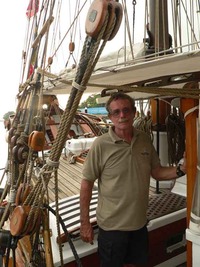
Captain Granger: We are just messengers.
Singapore, 15 April 2010. Only once or twice in a lifetime you would come across a fairy tale come true – that somewere out in the deep blue, a valiant vessel would appear, braving treacherous storms and worrying winds, to anchor off remote islands to bring supplies. Much needed supplies that heal the body and touch the hearts of islanders who could go through a year or two, or maybe ten, without ever seeing a foreign soul, let alone a visiting medical practitioner.
Captain Shane Granger and companion Margarete Macoun are two outstanding individuals who have dedicated their skills, time and money to extend humanitarian assistance on board the historical 117-year-old Vega, sailing to the end of the world to lend a hand.
That is, if there’s enough fuel.
“I would say fuel is one of the biggest controlling factors on where and how far we can go in any year. We simply do not at this point have enough fuel to get to our usual places,” says Shane, at present in Singapore, repairing the anchor winch and drumming up voyage plans (and funds).
The usual places referred to are faraway places such as Solomon islands and Papua New Guinea where he and Megge, together with volunteers, have delivered medical aid and educational materials that cater to the needs of the island or coastal inhabitants.
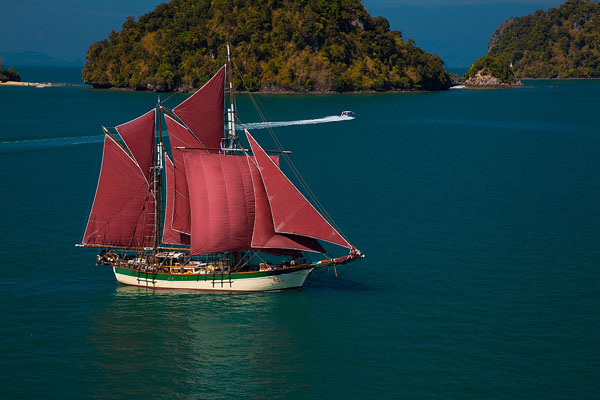
Cruising for humanitarian aid: The Vega.
Often these islands are not well chartered, making it hard to pin point, and surrounded by barrier or fringe reefs, making it difficult to maneuver into a bay or harbour without getting wrecked. Shane, with plenty of years of experience, is called upon (if he doesn’t volunteer it himself) to navigate around these challenging obstacles to reach needy people.
Shane and Megge, remarkable people in my opinion, remain humble when they talk about their roles in helping others.
“The work we do is really very mundane”, says Shane Granger. “Mostly we provide support for the local medical services in the form of transportation, accommodation, and supplies so they can do their work. I wish people could see how those dedicated nurses and doctors struggle to provide adequate medical services when they have almost nothing to work with. They are the real heroes of the story.”
“Along the way we also try to help out the local teachers with educational supplies such as paper, pens, chalk, simple things but very important if they are not available.”
Shane and Megge see themselves as instruments of aid.
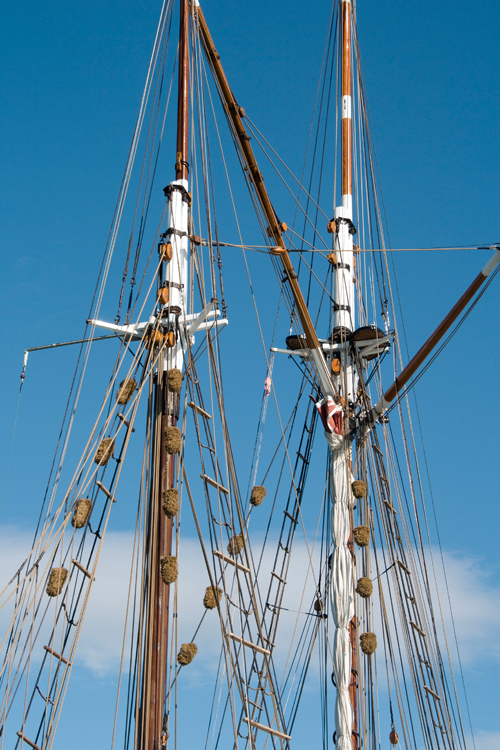
Aye, she's a pretty Galeass, no doubt.
“In 2008 we managed to provide complete up to date medical reference libraries for every hospital in the Solomon Islands. The total number of books and references provided were less than those in any normal European hospital. Yet they completely changed the Solomon’s medical system,” says Shane.
“We didn’t do it, people who believe in our work did. That is the kind of success we cherish. Our work is not about sweeping global changes demanding millions of Euros: it is about providing an old lady with a walker, a fisherman with fishing hooks, or a child with immunizations.”
While getting his boat ready for the next voyage, Shane tells me rather excitedly that his participation at Boat Asia 2010 in Singapore drew public awareness for his mission. “The head of Parkway Clinic in Singapore is in contact with Dr Donald Kafa in Solomon Islands about supporting his drastically under equipped small hospital with equipment and supplies no longer needed here in Singapore. To us that represents a major success.”
Dr Donald Kafa has been a longtime and tireless champion of health in the Solomon Islands, dedicated to improving the lives of the people by improving medical and dental facilities, capabilities and resources.
Vega’s Rich History
I came upon this relic that docked next to my mate Captain Ian Harbour’s restored 118-foot long gaff rigged topsail ketch - The Cariad - at the Boat Asia 2010. The Cariad itself carries history, in particular 113 years of high sea journeys, and is a work of art, having been cared for by a few craftsmen, my mate included, over the years to preserve its legacy. It is for sale, going cheap at USD3.5 million. Small tag to own a slice of history.
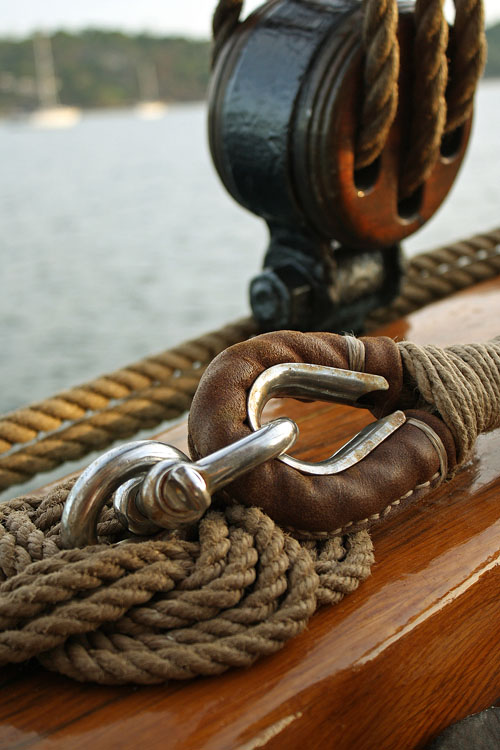
Rigging detail, work of art.
The Vega is different. It is an 85-foot long wooden Galeass with 17 feet high beam, cruising at 6 to 8 knots. It is also not for sale.
“We do not feel we own Vega,” says its master, Captain Shane Granger. “We are only temporary custodians of a piece of maritime history. It is our duty to insure she is capable of surviving yet another 100 years in the same or better condition than when we found her. Vega is for the future, for our great great grand children to admire and hopefully appreciate.”
The Vega in fact embodies the very legacy the vessel was built way back in 1893. After 117 years, the boat is standing tall, impressive, remnant of the Pirates of the Caribbean flick with the omnipresent rigging and tall sails. It is one of the very few to earn the title of a “historical” vessel.
The air of mystery is immediately quelled when Captain Grange appears on deck to very modestly tell you that the fine woodwork was all put together painstakingly by hand with recycled teak from Bali. Not just the finishing, he stresses, but the structure, the panelling, the boards. The varnish is made of natural wax, and built to last. Passion for preserving the environment shines through, like the crack of dawn.
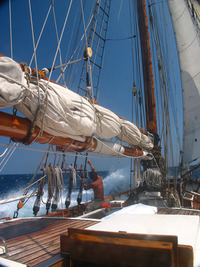
Riding through rough seas - all in a day's work.
Tearing my eyes away from the artistic knots and rigs, I focus on the architecture, which then invokes past eras of adventure and intrigue.
Built in 1893 by Norwegian Ola H. Nerhus, she was another of his famous “Hardanger jachts” to meet the highest standards set by Capt. Nils Vagan, of Herøysund, to be a deep-sea bulk carrier and be certified for Artic waters. This is a classification few vessels were strong enough to merit.
To this end, her construction was a blend of North Sea cargo ship and navel man-o-war. Both her scantlings and construction are strongly reminiscent of wooden navel ships of her period.
In 1905 she was sold to Alfred Olsson of Bergkvara, Sweden. After being modified and refit in Mr. Olsson’s boat yard, it was re-launched to become the legendary “VEGA of Bergkvara” under the Swedish flag.
Over the years Vega’s sailing rig changed back and forth between jagkt (cutter) and traditional Galeass (ketch). The Galeass with a history of 300 years is known for being seaworthy, extremely good in bad weather, and easily managed by a small crew.
Baltic traders like VEGA carried many types of cargo and made some very impressive voyages including immigrants to North America and cargos to the Mediterranean, Africa, and the Caribbean. Some even rounded Cape Horn to trade with Chile.
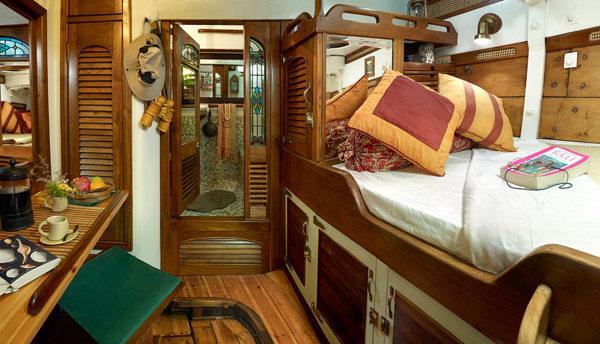
Recycled wood makes this vessel no less majestic, but perhaps more.
Now Vega is dedicated to a different type of cargo. A cargo of hope, a cargo of medical and educational supplies, and whenever possible local medical teams to isolated island communities.
I ask Shane why he took helm of The Vega for humanitarian missions. After a pause, Shane says, “I recall what Capt Irving Johnston, my old mentor said: Why do we go back to sea? It's the sunrise, the sunsets, and the stars at night that keep bringing us back. I guess that’s why we do what we do.”
But there’s a catch. They are out of fuel and need funds.

"The Vega's our home" - Granger
“As to money, we just work with what we have to do the most we can on, behalf of the people who support us and the people who need our help. We try to connect people and companies who want to help out with those who need help.”
Does your company have excess or unused equipment and materials that can help others? Are you looking for a unique cause to support? Contact The Vega if you do, and be part of a fairy tale that comes true to touch other’s lives.
Photographs courtesy of The Vega. Picture of Shane Granger by Mallika Naguran.
Contact: vega AT sailvega DOT com
www.sailvega.com